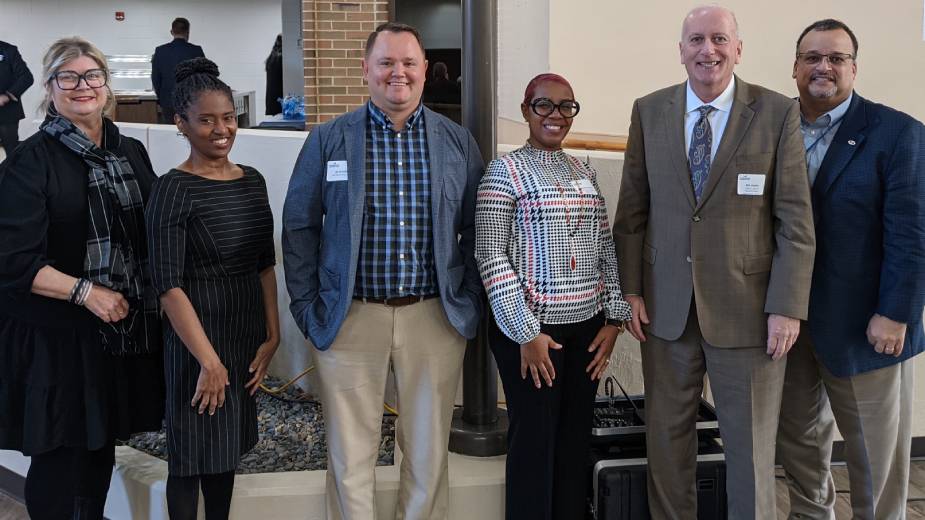Nonprofits Make Their Case — Their Business Case
AUSTINTOWN, Ohio – Stephanie Shaw explained nonprofit organizations have a very significant, far reaching impact on the American economy, bolstering local, state and national economies in many ways.
The executive director of the Marion G. Resch Foundation and five other panelists spoke Tuesday during the Youngstown/Warren Regional Chamber Lunch and Learn Series at the Mahoning Valley Campus of Care – formerly the Youngstown Development Center.
Shaw, who was the moderator for the event, says the United States has 1.3 million charitable nonprofit organizations, employing more than 12 million with payrolls exceeding other industries such as construction, transportation and finance. In Ohio, 12.3% of the workforce is employed through a nonprofit organization, with 92% of nonprofits’ annual budgets are smaller than $1 million.
The annual compensation produced by nonprofits is more than $826 billion, she says.
Still, it’s important for the public to understand that the needs of a nonprofit are no different than any other professional organization. And just like the private sector, attracting and retaining talent among nonprofits through competitive salaries and wages is integral to quality and service.
“If we don’t have a profit, we don’t exist,” says Joseph Caruso, president and CEO of Compass Family & Community Services. “Unfortunately people in our community think sometimes that we don’t need to be compensated in the manner in which we should as professionals.”
Compass employs nurse practitioners, counselors with master’s degrees, nurses, psychiatrists, and business administrators, Caruso says. “They expect and deserve to make what their counterparts are making in the for-profit arena. The only thing we’re not doing is paying shareholder profits. We’re investing it in our organization and the people that we serve.”
Bob Hannon, president of the United Way of Youngstown and the Mahoning Valley, cites, for example, a campaign whose goal it is to raise $3 million. Those monies are distributed to the community after staffing and budgetary needs are met. Should the campaign exceed the mark, those monies are put in reserves as a rainy-day fund for the organization.
Hannon says his organization offers a fair compensation plan with flex time, allows employees to work from home and awards performance compensation.
“If you exceed your goals and expectations, then you are in line to get a performance compensation/bonus,” he says. “Now the company has to reach its overall goal to get there.”
Hannon says most of the corporate professionals he works with no longer ask how much money is going into the program, but question whether these programs are making a real impact.
“If you’re not doing anything, not moving the needle, why should I fund you?” he says.
Becky Keck, Students Motivated by the Arts president or Smarts, says 80% of her expenses went to employees.
“Do you want the best piano teacher for your child, or the cheapest?,” she says.
Stephanie Gilchrist, director for the minority business assistance center at the Youngstown Business Incubator, wants to dispel the theory that nonprofit means broke and not growing as a professional.
“Profit is the results, those people or children I serve,” she says.
Allowing more people to work from home and using technology to a company’s benefit is something Joseph Kilgore, principal at HD Davis CPAs LLC, sees as a growint trend to retain talent. HD Davis employs bookkeepers all over the country who work with nonprofits.
“If somebody’s ready to work, I’m not going to tell them no,” he says.
According to IRS master files for the fiscal year ending in 2018, revenues by nonprofits are: 49% earned fee for service, 31.8% earned government contracts, 8.7% individual donations, 2.9% by foundations, 1.5% donated requests, 0.9% donated corporations and 5.2% are other.
Caruso, who has says his company’s financial statements are very close to these numbers, says Compass serves more than 12,000 people in Trumbull and Mahoning counties every year.
“We earn our revenue,” he says. “No one gives it to us. It’s not a handout,” he says. “We’re not a group of volunteers. We’re a group of professionals that are doing a service to our community.”
Giving has changed over the years. Hannon says when he started in 2008, 66% of the dollars raised were coming out of people’s paychecks. Today, that number is down to 48%, underscoring the importance of corporate donations and grant contributions.
“If we just relied on workplace giving, financially we’d be in a lot of trouble,” Hannon says.
Many nonprofits are straining to meet the public’s increased need. According to a survey administered by the nonprofit finance fund, 57% of nonprofits reported that their organizations couldn’t meet demand, while 79% of the demand for service increased.
Gilchrist says she serves Ashtabula to Jefferson counties with just three people.
“It’s crazy that a lot of people don’t see that as a need for us, or to help the small businesses, which are our future,” she says.
Keck says Smarts can’t grow fast enough. The community partners have recently realized how learning in the arts impacts children’s overall development, and want Smarts in their schools.
“We stand up and say we’re businesses as well. Period,” Caruso says.
He sets a goal of 11-12% for administrative cost, but is currently at 15% with 42 funding sources that Compass earns money for that is in excess of $100,000.
“Our administrative burden to report to all of these different funding sources far outweighs any other for-profit entity that’s out there,” Caruso says.
Compass employs 320, but has 37 open positions with a payroll of $9.5 million. Auditors come in on a monthly basis to examine finances, programs or any of the organization’s funding sources.
“How can you decrease administrative expenses when you have that amount of scrutiny that you have to go through?” Caruso asks.
Gilchrist talks about bringing in top talent into the Mahoning Valley.
“We talk about Brain Gain in Ohio, and Youngstown in particular,” Gilchrist says. “If you want that Brain Gain, if you want that top talent, you have to give them a place they want to come and work.”
Pictured at top: Becky Keck, Stephanie Shaw, Joseph Kilgore, Stephanie Gilchrist, Bob Hannon and Joseph Caruso.
Copyright 2024 The Business Journal, Youngstown, Ohio.



